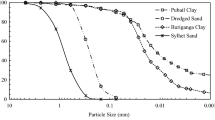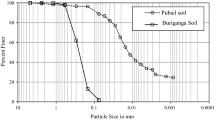Abstract
Field pull-out and laboratory tests were applied to investigate the effect of metal bolts and wire netting on plant root distribution and anchorage characteristics of 9-year-old Vitex negundo L. growing on a weakly weathered rocky slope (38°). Root number, length and diameter were recorded and single root specimens were classified and tested for tensile strength. The results show that root anchorage is different between the two constructions by bolts and wire. Under limited soil condition, root anchorage ability is 80% lower than when there is sufficient soil due to the reduction of the diameter and number of all second-order lateral roots, as well as the reduction of the tensile strength of the embedded second-order and first-order lateral roots on limited soil. We conclude that the distribution and anchorage of Vitex negundo L. is affected by limited soil availability on rocky slopes.
Similar content being viewed by others
References
Canadell J, Jackson RB, Ehleringer JB, Mooney HA, Sala OE, Schulze ED (1996) Maximum rooting depth of vegetation types at the global scale. Oecologia 108: 583–595.
Bischetti GB, Bonfanti F, Greppi M (2003) Root tensile strength measurement: testing device and protocol. Quaderni di Idronomia Montana 21: 349–360 (In Italian).
Chiatante D, Scippa GS, Di Iorio A, Sarnataro M (2001) Root architecture modified by mechanical stress in seedlings of Fraxinus ornus L. and Spartium junceum L. growing on slopes. In: Radoglou K (ed.), Proceedings of the International Conference, Thessaloniki, Greece. pp 477–482.
Chiatante D, Sarnataro M, Fusco S, Di Iorio A, Scippa GS (2003a) Modification of root morphological parameters and root architecture in seedlings of Fraxinus ornus L. and Spartium junceum L. growing on slopes. Plant Biosystems 137: 47–56.
Chiatante D, Baraldi A, Di Iorio A, Sarnataro M, Scippa GS (2003b) Root response to mechanical stress in plants growing on slopes: an experimental system for morphological, biochemical and molecular analysis. In: Roots, the Dynamic Interface between Plants and the Earth. The 6th Symposium of the International Society of Root Research, Nagoya, Japan. pp 421–427.
Chiatante D, Scippa GS, Di Iorio A, Sanataro M (2003c) The influence of steep slope on root system development. Journal of Plant Growth Regulation 21:247–260.
Coutts MP (1987) Developmental process in tree root systems. Canadian Journal of Forest Research 17: 761–767.
Coutts MP, Nicoll BC (1991) Orientation of the lateral roots of trees. Upward growth of surface roots and deflection near the soil surface. New Phytologist 119: 227–234.
Dearman WR, Baynes FJ, Irfan TY (1978) Engineering grading of weathered granite. Engineering Geology 12: 345–374.
Di Iorio A, Lasserre B, Scippa GS, Chiatante D (2005) Root system architecture of Quercus pubescens trees growing on different sloping conditions. Annals of Botany 95: 351–361.
Gartner BL (1994) Root biomechanics and whole-plant allocation patterns, responses of tomato plants to stem flexure. Journal of Experimental Botany 45: 1647–1654.
Genet M, Stokes A, Salin F, et al. (2005) The influence of cellulose content on tensile strength in tree roots. Plant and soil 278:1–9.
Gray DH, Sotir RB (1996) Biotechnical and Soil Bioengineering Slope Stabilization: A Practical Guide for Erosion Control. JohnWiley and Sons, New York.
Goodman AM, Ennos AR (1996) A comparative study of the response of the roots and shoots of sunflower and maize to mechanical stimulation. Journal of Experimental Botany 46: 1499–1507.
Goodman AM, Ennos AR (1997) The responses of field-grown sunflower and maize to mechanical support. Annals of Botany 97: 703–711.
Goodman AM, Ennos AR (1998) Responses of the root systems of sunflower and maize to unidirectional stem flexure. Annals of Botany 82: 347–358.
Jaffe MJ (1973) Thigmomorphogenesis: the response of plant growth and development to mechanical stimulation. Planta 114: 143–157.
Ji SW (2000) Survey report of foreign highway slope, Danjingshan, Pengzhou city. The Survey Report Sets of Survey and Design Institute, Communications Department, Sichuan. pp 53–55. (In Chinese)
Li SC, Sun HL, Yang ZR, et al. (2007) Root anchorage of Vitex negundo L. on rocky slopes under different weathering degrees. Ecological Engineering 30: 27–33.
Mallik AU, Rasid H (1993) Root-shoot characteristics of riparian plants in a flood control channel: Implications for bank stabilization. Ecological Engineering 2: 149–158.
Marler TE, Discekici HM (1997) Root development of "Red Lady" papaya plants grown on a hillside. Plant and Soil 195: 37–42.
Mattia C, Bischetti GB, Gentile F (2005) Biotechnical characteristics of root systems of typical Mediterranean species. Plant and soil 278: 23–32.
Nicoll BC, Easton EP, Milner AD, et al. (1995) Wind stability factors in tree selection: distribution of biomass within root systems of Sitka spruce clones. In: Coutts MP, Grace J (eds.), Wind and Trees. Cambridge University, Cambridge. pp 276–292.
Nicoll BC, Ray D (1996) Adaptive growth of tree root systems in response to wind action and site conditions. Tree Physiology 16: 891–898.
Nie DX, Han AG, Ju GH (2002) Study on integrated zoning of weathering degree of rock mass. Journal of Engineering Geology 10:20–25. (In chinese)
Niklas KJ (1998) Effects of vibration on mechanical properties and biomass allocation pattern of Capsella bursa-pastoris (Cruciferae). Annals of Botany 82: 147–156.
Norris JE, Di Iorio A, Stokes A, et al. (2008) Slope stability and erosion control: Ecological solutions. Springer, Netherlands pp 167–210.
Richter W (1984) A structural approach to the function of buttresses of Quararibea asterolepis. Ecology 65: 1429–1435.
Stokes A, Berthier S, Sacriste S, Martin F (1998) Variations in maturation strains and root shape in root systems of Maritime pine (Pinus pinaster Ait.). Trees-Structure and Function 12: 334–339.
Stokes A, Guitard D (1997) Tree root response to mechanical stress. In: Altman A, Waisel Y (eds.), Biology of root formation and development. Plenum Press, New York. pp 227–236.
Stokes A, Fitter AH, Coutts MP (1995) Responses of young trees to wind and shading: effects on root architecture. Journal of Experimental Botany 46: 1139–1146.
Stokes A, Martin F, Sacriste S, Fourcaud T (1997a) Adaptation of tree roots to wind loading-the relationship between mechanical behaviour and wood formation. In: Jeronimidis G, Vincent JFV (eds.), Plant bio-mechanics (conference proceedings I, papers). Centre for Biomimetics, University of Reading. pp 339–346.
Stokes A, Nicoll BC, Coutts MP, Fitter AH (1997b) Responses of young Sitka spruce clones to mechanical perturbation and nutrition, effects on biomass allocation, root development, and resistance to bending. Canadian Journal of Forest Research 27: 1049–1057.
Stokes A (2002) Biomechanics of tree root anchorage. In: Waisel Y, Eshel A, Kafkafi U (eds.), Plant Roots: The Hidden Half. Marcel Dekker, Inc., New York. pp. 175–186.
Telewski FW (1995) Wind-induced physiological and developmental response in trees. In: Coutts M, Grace J (eds.), Wind and wind related damaged to trees. Cambridge: Cambridge University Press. pp 237–263.
Thaler P, Pages L (1999) Why are laterals less a□ected than main axes by homogenous unfavorable physical conditions? A model based hypothesis. In: Stokes A, ed. The Supporting Roots of Trees and Woody Plants: Form, Function and Physiology. Durdrecht, Netherlands: Kluwer. pp 209–218.
Tosi M (2007) Root tensile strength relationships, their slope stability implications of three shrub species in the Northern Apennines (Italy). Geomorphology 57: 268–283. Doi: 10.1016/j.geomorph.2006.09.019.
Yan MM, Xu ZX, Su ZY, et al (2004) Geotechnical anchorage technical manual. China Communications Press, Beijing. (In Chinese)
Author information
Authors and Affiliations
Corresponding author
Rights and permissions
About this article
Cite this article
Long, F., Li, S., Sun, H. et al. Influence of limited soil on the root distribution and anchorage of Vitex negundo L.. J. Mt. Sci. 9, 723–730 (2012). https://doi.org/10.1007/s11629-012-2288-7
Received:
Accepted:
Published:
Issue Date:
DOI: https://doi.org/10.1007/s11629-012-2288-7




